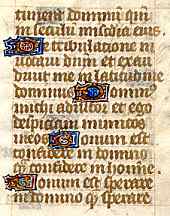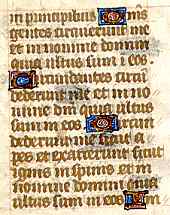

The red ink ruling lines for laying out the text on the page can also be seen. It is also apparent that in a few places the painted initials have partially covered the brown ink letters of the text, so we have a little insight into the order in which things were done on the page.
There is an anomaly in the text, as one verse of the Psalm is missing. On the recto it should read:
Dominus mihi (or michi) adiutor non timebo quid faciat mihi homo
Dominus mihi adiutor et ego despiciam inimicos meos
However, it seems the scribe may have been tricked by the repeating words, and has left out the first line.
| overview | initials | text | alphabet | abbreviations | exercises | transcript | translation |
If you are looking at this page without frames, there is more information about medieval writing to be found by going to the home page (framed) or the site map (no frames).